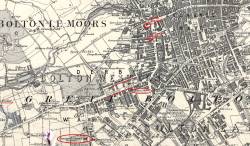


Commission Street

This picture, 'MAP 1847 East Bolton', was taken in 1847 and sourced from Newspaper - Walter Mather Obituary.
- Picture Notes
- East Bolton showing Christ Church and St Paul Deansgate & Emmanuel Churches etc
Place Notes
Bolton or Great Bolton (see also Little Bolton)
In 1773, Bolton-le-Moors was an unenclosed Moor of about 250 acres. Great and Little Bolton were mainly rural areas with only 5,339 inhabitants living in 1,178 houses.
Little Bolton was separated from Great Bolton by the River Croal. Little Bolton consisted chiefly of Turton Street, Kay Street, Bark Street and Chorley Street with a few odd houses and folds. The town was ill paved, unlit and partly drained by open gutters. There was no water supply, but the cellars of houses would often contain a pump or well. The Old Dungeon stood on windy bank, now Bank Street. A house for the poor was erected in 1785.
The main industries were spinning and weaving – fustians and cotton velveteens. In 1768, of 143 Methodists. 100 were spinners, the others being warpers, crofters, carders, sizers and winders. People would often have a sideline such as cow-keeping or farming.
John Kay, of Bury, invented the fly shuttle in 1733 which prepared the way for James Hargreaves’s Spinning Jenny in 1767. In 1769, Richard Arkwright gave up wig making to develop the water spinning frame. Then, in 1769, James Watts used a condensing steam engine to drive the coming mills created by Samuel Crompton’s mule. This revolutionised spinning and laid the foundation for the growth of Bolton.
The roads in Lancashire in the middle of the eighteenth century were poor, with wheeled traffic was impossible and so everything was carried by packhorse. About 1780, a stagecoach was started between Bolton and Carlisle, which was probably transported the Mather families of Preston to Bolton at this time. Soon, coaches connected Bolton and Manchester, running several times a day. Also there were daily coaches to London and Edinburgh. The canal opened in 1791 sending goods and passengers to Oldfield Lane, Manchester.
- References (8)
- Parent Place: Bolton
- Place: 32 Commission Street
- 1841 Occupancy/Contact: Jane Mather (1841 - )
- 1841 Occupation: Cotton Weaver James (Jacobi) Mather (1841 - )
- 1851 Occupancy/Contact: primary residence Alice Hartley, James Mather, Margaret Wood (1851 - >1871)
- 1851 Occupancy/Contact: primary residence James Mather (1851 - >1871)
- 1861 Occupation: Muslin Weaver (Cotton) James Mather (1861 - 1871)
- 1911 Occupation: Cart Sheet Maker John Richard Tomlinson (1911 - )